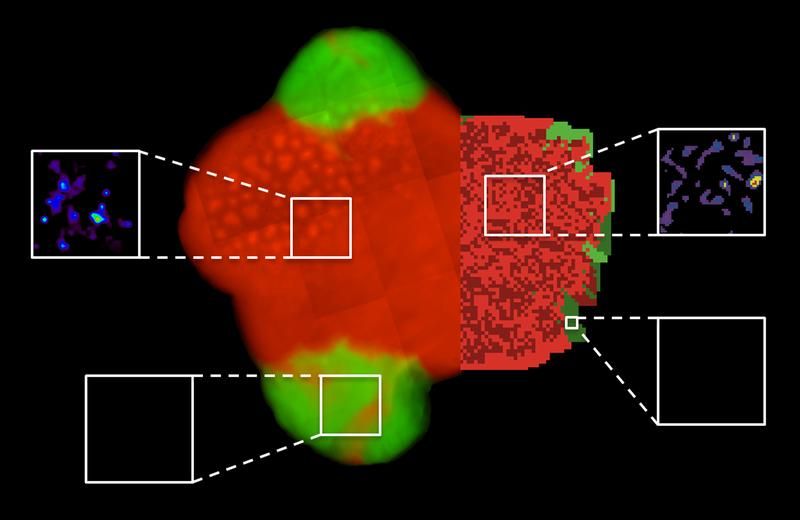Cooperating bacteria isolate cheaters
Advertisement
bacteria, which reciprocally exchange amino acids, stabilize their partnership on two-dimensional surfaces and limit the access of non-cooperating bacteria to the exchanged nutrients. Scientists at the Max Planck Institute for Chemical Ecology and the Friedrich Schiller University in Jena have shown that bacteria, which do not actively contribute to metabolite production, can be excluded from the cooperative benefits. The research team demonstrated that cooperative cross-feeding interactions that grow on two-dimensional surfaces are protected from being exploited by opportunistic, non-cooperating bacteria.

Amino acid measurements: Concentrations are high in the vicinity of cooperative bacteria (above). In contrast, no amino acids were detectable in areas surrounding non-cooperative bacteria (below).
S. Lang / Friedrich-Schiller-Universität Jena
In natural microbial communities, different bacterial species often exchange nutrients by releasing amino acids and vitamins into their growth environment, thus feeding other bacterial cells. Even though the released nutrients are energetically costly to produce, bacteria benefit from nutrients their bacterial partners provide in return. Hence, this process is a cooperative exchange of metabolites. Scientists at the Max Planck Institute for Chemical Ecology and the Friedrich Schiller University in Jena have shown that bacteria, which do not actively contribute to metabolite production, can be excluded from the cooperative benefits. The research team demonstrated that cooperative cross-feeding interactions that grow on two-dimensional surfaces are protected from being exploited by opportunistic, non-cooperating bacteria. Under these conditions, non-cooperating bacteria are spatially excluded from the exchanged amino acids. This protective effect probably stabilizes cooperative cross-feeding interactions in the long-run.
Indeed, in a previous study, the researchers could already demonstrate that this division-of-metabolic-labor can positively affect bacterial growth. In the new study, they addressed the question how such cooperative interactions can persist if non-cooperating bacteria consume amino acids without providing nutrients in return. The evolutionary disadvantage that results for cooperative cells could lead to a collapse of the cross-feeding interaction.
To experimentally verify this possibility, the scientists have monitored co-cultures of cooperating and non-cooperating bacteria. For this, they genetically engineered “cooperators” of two bacterial species that released increased amounts of certain amino acids into their environment. “As a matter of fact, non-cooperators grew better than cooperators in a well-mixed liquid medium, because under these conditions, they had an unrestricted access to the amino acids in the medium. Their growth, however, was considerably reduced when placed on a two-dimensional surface,” said Kost, summarizing the results of the experiments. A more detailed analysis revealed that non-cooperating bacteria could only exist at the very fringe of colonies consisting of cooperating bacteria.
For their study the scientists combined different methods and techniques. The basis formed a new research approach called “synthetic ecology”, in which certain mutations are rationally introduced into bacterial genomes. The resulting bacterial mutants are then co-cultured and their ecological interactions analyzed. In parallel, colleagues at the Friedrich Schiller University from the Department of Bioinformatics developed computer models to simulate these interactions. Finally, chemical analyses using mass spectrometric imaging was instrumental for visualizing the bacterial metabolites. Only the combination of microbiological methods with chemical-analytic approaches and computer simulations enabled the scientists to understand and elucidate this phenomenon.
“The fact that such a simple principle can effectively stabilize such a complex interaction suggests that similar phenomena may play important roles in natural bacterial communities,” Christian Kost states. After all, bacteria occur predominantly in so-called biofilms – these are surface-attached slime layers that consist of many bacterial species. Moreover, biofilms are highly relevant for medical research: They do not only play important roles for many infectious diseases by protecting bacterial pathogens from antibiotics or the patients’ immune responses, but are also highly problematic when colonizing and spreading on the surfaces of medical implants.
This new study has elucidated that cooperating bacteria form cell clusters and in this way exclude non-cooperating bacteria from their community. “The importance of this mechanism is due to the fact that no complicated or newly-evolved condition, such as the recognition of potential cooperation partners, needs to be fulfilled to effectively stabilize this long-term partnership. Two cooperating bacterial strains and a two-dimensional surface are sufficient for this protective effect to occur”, explains Kost.
The study raises many new exciting questions the researchers plan to address in the future. For example, they are interested in whether or not similar synergistic effects occur when more than two bacterial partners are involved. In their natural habitats, it is likely that more than two bacterial species participate in such cooperative interactions, leading to rather complex interaction networks. Moreover, amino acid-producing bacterial mutants were synthetically generated for this study. Whether also naturally evolved “cooperators” that occur in a habitat like soil show similar dynamics, remains to be verified. Given that bacteria frequently occur in biofilms, cooperative cross-feeding is probably much more widespread than previously thought. Understanding the factors and mechanisms that promote or inhibit bacterial growth could thus provide important clues on how to fight harmful bacteria or to better use beneficial ones.




















































